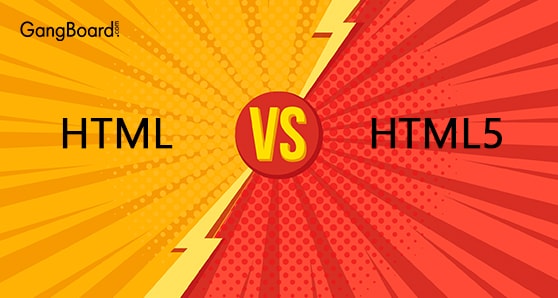
HTML Vs HTML5
HHTML Vs HTML 5
In computer processing, mark-up language is a system or a language that is used to define the element with tags in a document. The idea of the mark-up language is evolved from the concept of marking manuscripts in a paper or a hard copy document, in which the revisions and updates are performed by the editors and reviewer with a highlight pen or a pen in different colour especially in red or blue colour.
Some of the widely used mark-up languages are Latex, XML, and HTML. In this Blog, let us get some details on HTML and HTML5. Hypertext Mark-up Language is the acronym of HTML and the widely used higher version of HTML is HTML5. HTML and HTML5 are the standard mark-up languages used for creating web pages and application, where HTML5 is the higher version evolved from the standard HTML. From this page, you will get a deep understanding on HTML and HTML5 and also the differences between both the mark-up languages (HTML and HTML5).
Before we start understanding the difference and comparison between HTML and HTML5, let us first explore more on what is mark-up language. The standard mark-up language is a tool used to keep the web pages and application well organized and easily accessible. It is also called as the process to define text, embed tags and scripts, and manipulate text annotations with the help of diverse file tags. HTML stands as the most popular mark-up language where the HTML5 stands as the advanced version of the standard HTML.
The HTML document stored in the local storage is sent to the web browser where the HTML document is rendered as web pages. HTML pages are designed using the HTML elements. These HTML elements are used to create a structured web page with headings, paragraphs, links, lists, images, quotes, variables, and objects.
Mark-up Languages rules the web world because they are the mostly used and the basic tools required to create a webpage. Each webpage will include text, images, links, variables, and other kind of structured content that has to be displayed in the screen for the intended user. The mark-up languages provide us a way to present the textual or visual information to the user, in an intended way.
While designing a webpage, we may need to consider the different objects such as fonts, colours, and text types. In mark-up, we need to make these as the universality objects. This makes the web page look similar irrespective of the web browsers used by the user. To provide this comfort to the user, we need it is necessary to have a common mark-up language by which the web pages present the data in the web browsers to the users.
Difference Between HTML and HTML5:
|
HTML |
HTML5 |
|
HTML is the acronym of Hypertext Mark-up Language, which is the standard mark-up language that includes Cascading Style Sheets (CSS) and JavaScript for creating web pages and web applications. HTML document is the main core part in rendering the multimedia web pages. |
HTML5 is a software solution stack, which is formerly known as HTML5 [a]. HTML 5 is used to define the properties and behaviours of the content in the web pages by implementing the mark-up based pattern to it. HTML 5 is the fifth version of the HTML mark-up language and it is current major version used globally. |
|
HTML uses the cache of the browser as the temporary storage |
HTML5 provides us various options such as SQL database, web storage, and application cache, for storage. |
|
HTML also allows you to embed programs developed in a scripting language such as JavaScript, which controls the appearance, content, and behaviour of web pages. The Cascading Style Sheets (CSS) controls and defines the look and feel of content. |
HTML5 also supports embedding programs developed in a scripting language such as JavaScript. |
|
In HTML, audio and video integration in web pages is difficult or nearly not possible. |
HTML5 mark-up language provides more benefits to developers when come to audio and video integration in web pages. |
|
HTML is the old and first version, which does not claim APIs. |
The latest version of HTML, which is HTML5, claims more API’s than its predecessor. |
|
Presenting mathematical notations is difficult in HTML. |
The mathematical notations can be presenter better in HTML5 than its previous versions of HTML. |
|
HTML is not very much compatible across all platforms. |
HTML5 contains well-improved parsing, this makes easy to provide better compatibility across all the platforms. |
|
HTML allows limited input attributes and form controls. |
HTML5 allows better input attributes and form controls than its earlier versions.
|
|
HTML contains simple processing models. |
HTML5 contains the detailed processing models to boost the interoperable implementations. |
|
HTML cannot be used in cross-platform mobile applications. |
HTML5 is also used in cross-platform mobile applications. This is used here mostly because it includes the features mainly designed for low-powered devices. |
|
HTML allows Java Script to perform only the interface of the browser. |
HTML5 follows JavaScript code to run in the background of the browser through JavaScript web worker API. |
|
HTML does not allow us to include audio and video tags in the programs |
HTML5 allows the audio and video tags and their controls. |
|
HTML do not allow or support the drawing of the different geometrical shapes. |
HTML5 allows drawing any shapes you want. |
|
HTML 5 offers better UX features, in mobile functionalities. |
HTML5 offers better UX features, in mobile functionalities, to provide more support than HTML. |
|
In HTML, we have to type along doc type declarations in HTML. |
HTML5 we can perform it in a very less time. |
|
Thinking the geographic location of the users is nearly impossible in HTML. |
In HTML5 it is quite easy with the help of JavaScript geo location API. |
|
Vector graphics is also possible in HTML, but we need the help of some other technologies such as silver Light, Flash, VML, etc. |
Vector graphics is made easy in HTML 5, because vector graphics comes as an integral part of HTML5. |
|
Drag and drop option is not present in HTML. |
HTML5 allows us to develop drag and drop effects in the web pages. |
|
Webpages developed in HTML is only supported in old browsers or old version of browsers. |
Webpages developed in HTML5 is supported in all the new browsers and latest version of the browsers. |
|
Document type declaration is tedious and little complicated in HTML. |
In HTML5 the Document type declaration is quite simple and cool. |
|
Character encoding is tedious and little complicated in HTML. |
In HTML5 Character encoding is very simple and comfortable. |
|
HTML does not have socket support so the communication between the server and the client is performed by streaming and pooling. |
HTML5 has the web socket support and the communication between the server and the client is full duplex. |
|
HTML does not have the capability to handle errors.
|
When there is an error, HTML5 is capable of handling inaccurate syntax errors and other simple errors. |
The advantages of HTML 5 over HTML are:
- HTML5 provides various storage options.
- HTML5 provides better JavaScript support. You can include JavaScript in the background with the help of JavaScript APIs.
- HTML5 provides a better audio and video support with the help of incorporating third party plug ins.
- HTML5 provides better compatibility across all the platforms.
- HTML5 improves the mark-up language usage for documents and application programming interfaces (APIs).
- HTML5 features are user friendly features for low-powered devices.
Conclusion
All together HTML5 processes many advantages over HTML due to its innovative features and the feasible tools. The advancement in markup language that is HTML5 has created a wave of change and maximized the potential of the usage in web browsers, this makes the developer/ coders to prepare and shift to HTML5 over HTML.


 +1 201-949-7520
+1 201-949-7520 +91-9707 240 250
+91-9707 240 250